Researchers discuss how dry pine forests, dry and wet mixed-conifer forests, and dry and moist mixed-conifer forests in the US Pacific Northwest (PNW) area were influenced by a continuum of 19th–21st-century sociopolitical activities and management techniques in this study. The research was published in Frontiers in Ecology and the Environment.
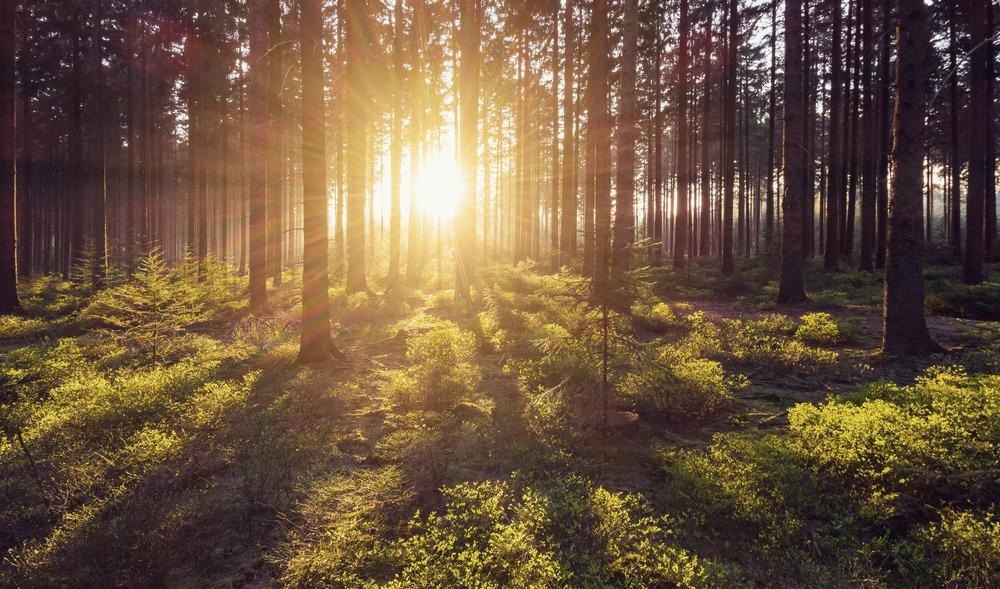
Image Credit: Grisha Bruev/Shutterstock.com
To address extensively changed forest successional circumstances, 20th- and 21st-century climatic shifts, and quickly shifting wildfire regimes in the present age, scientists suggest landscape-level adaptation.
Wildfires were viewed as entirely detrimental to western landscapes after the “Big Burn,” and laws were devised to ensure that subsequent flames were rapidly suppressed. Following that, the federal government prioritized fire control to safeguard people, infrastructure, and forests. With the implementation of the “10-am rule” in 1935, high suppression efficacy and reduced burnt area became obvious (that is, fires extinguished by 10 am after identified).
Old woods were iconic to many people who prized them for their inherent recreational, aesthetic, spiritual, and ecological significance. Old woods were prized by Native American tribal people for supplying food and medicine, preserving spiritual and cultural rituals, and fostering intergenerational linkages to ancient customs.
One proposed policy in inland PNW woods would prevent the cutting of any tree greater than the 53 cm diameter at breast height (dbh), which was seen to be a reasonable lower cutoff for ancient trees and forests at the time. The implementation of the policy increased the openness of forest management as it related to large trees, as well as alleviating public worries about giant tree removal; nonetheless, it ignored tree age and species, as well as rural community requirements.
As a result, enforcing the giant tree strategy will increase the density and layering of shade-tolerant but fire-intolerant trees, raising the risk of crown fire initiation and spread in forests where it had previously been rare. As forest fuels accumulated and drought conditions deteriorated, aggressive fire suppression—performed to support community, resource, and habitat preservation—became increasingly expensive and ineffectual.
Many fire-intolerant trees have developed into bigger size classes after more than 170 years of fire exclusion, seen in Figure 1.
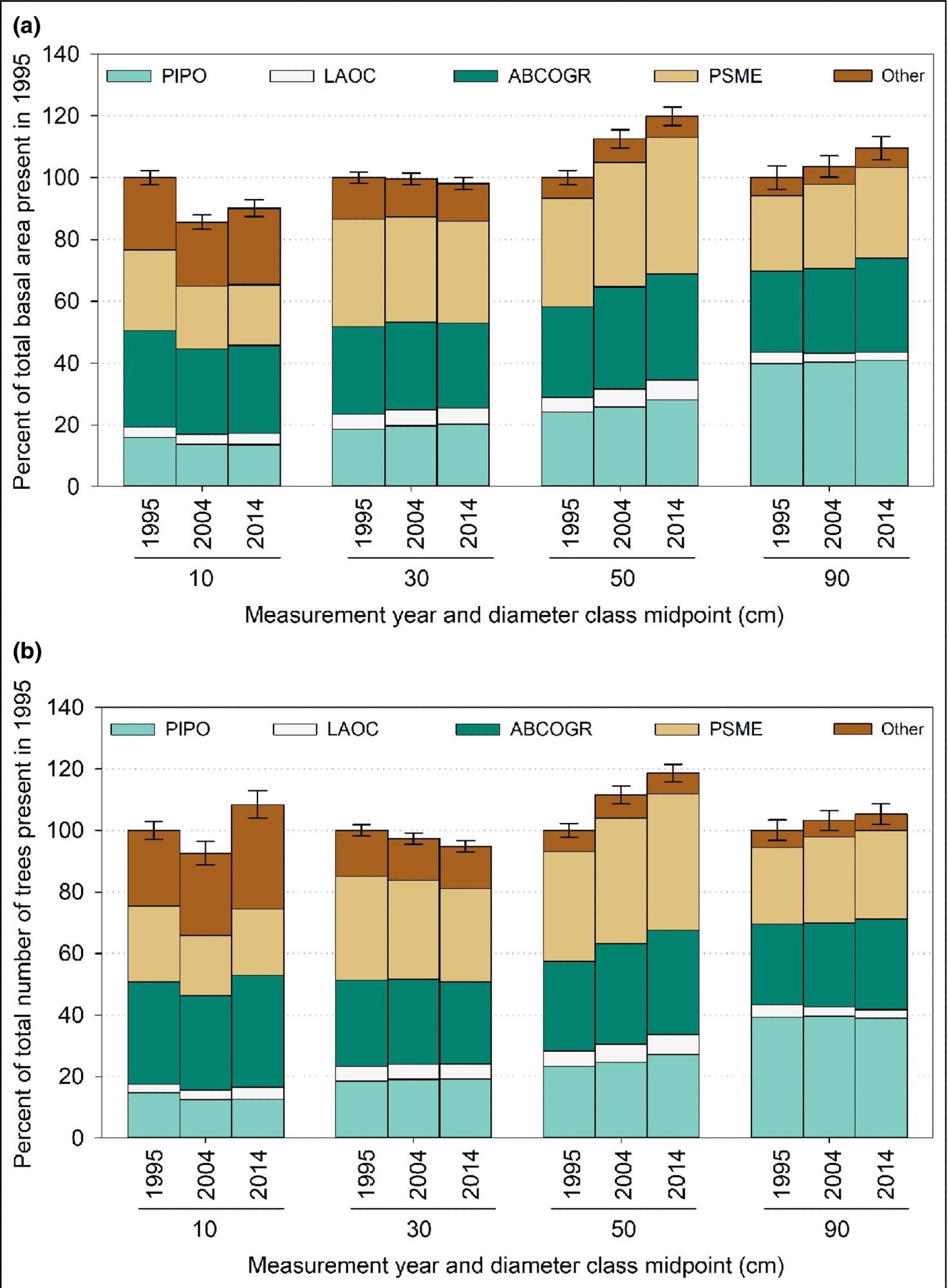
Figure 1. Species abundance has changed in mixed-conifer forests in recent decades. Estimates of (a) basal area per hectare (BAH) and (b) trees per hectare (TPH) on public lands in eastern Oregon and Washington were compiled from national and regional forest inventories. For each diameter class, bars from left to right represent estimates for midpoint inventory years 1995 (1990–1999), 2004 (2000–2007), and 2014 (2010–2017). Species include the fire-tolerant and shade-intolerant ponderosa pine (Pinus ponderosa, PIPO) and western larch (Larix occidentalis, LAOC); the shade-tolerant white fir (Abies concolor) or grand fir (Abies grandis) (together, ABCOGR) and Douglas fir (Pseudotsuga menziesii, PSME); and all other tree species combined (Other). Species proportions in 2004 and 2014 are relative to the BAH (above) and TPH totals (below) in 1995, for each diameter class. Diameter class midpoints are (left to right) 10 cm (range 2.5–20 cm), 30 cm (range 20–40 cm), 50 cm (range 40–60 cm), and 90 cm (range 60–120 cm). Results show overall increases in BAH and TPH for tree diameters >40 cm, with ABCOGR and PSME increasing more than PIPO, and LAOC generally declining. Error bars represent the standard error of the mean estimate. (a) The proportions of total BAH in the 10-cm, 30-cm, 50-cm, and 90-cm midpoint classes in 2014 were 16.9%, 35.1%, 27.5%, and 20.6%, respectively. (b) The proportions of total TPH in the 10-cm, 30-cm, 50-cm, and 90-cm midpoint classes in 2014 were 79.9%, 14.5%, 4.2%, and 1.4%, respectively. Note that the largest increases in BAH and TPH occurred in the 50-cm class. Image Credit: Hessburg, et al., 2022
Their findings showed that removing substantial intended burning enhanced the consequences of fire exclusion, as well as the potential advantages of intentional burning in lowering uncertainty, increasing the chance of less severe fires, and reducing the burnt area.
As a result, damaged forests are frequently uniform, thick, and stratified, as seen in Figure 2, with fuel ladders extending from near ground level to the crowns of surviving huge, ancient, fire-tolerant trees in Figure 3.
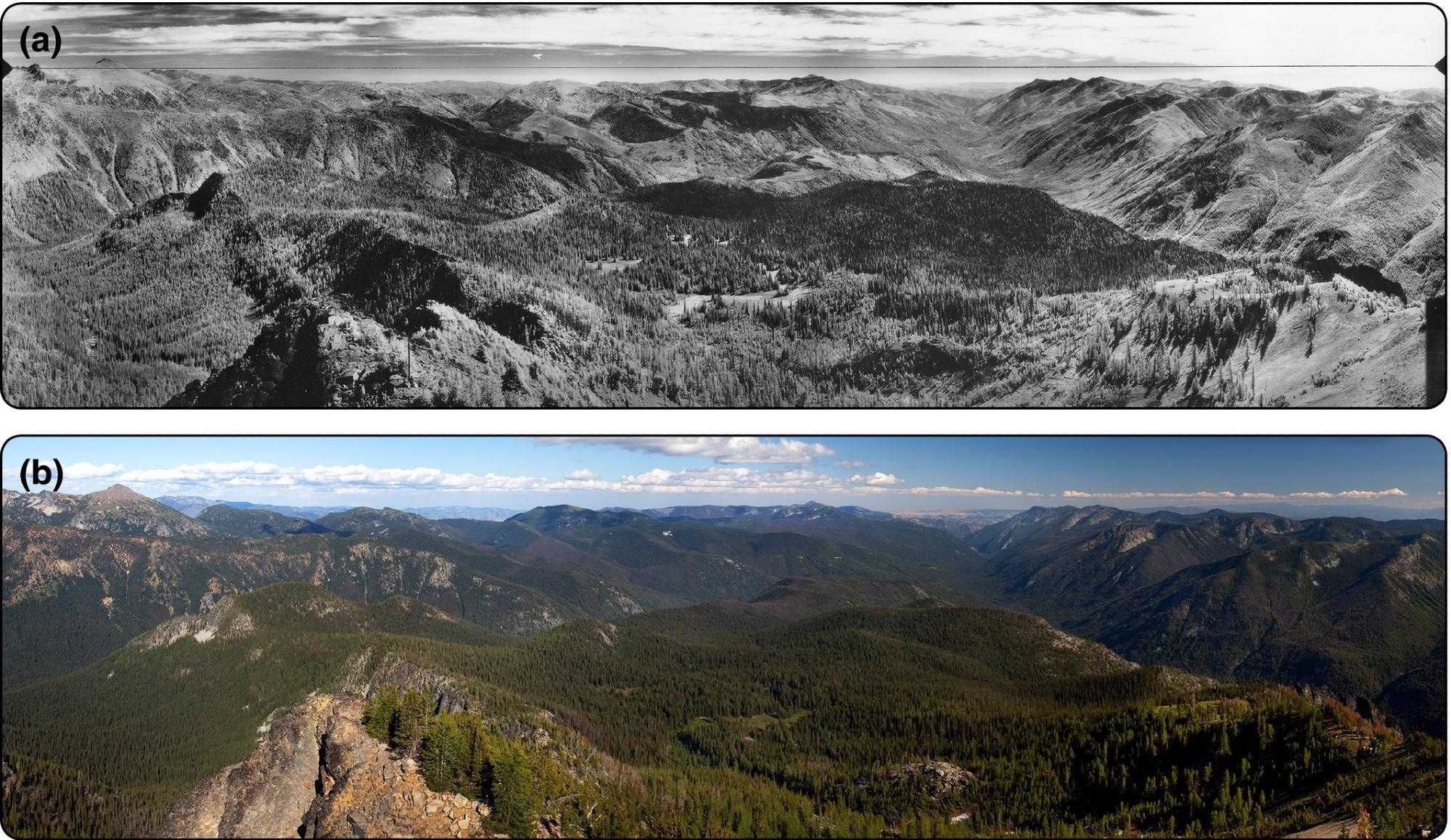
Figure 2. A densely treed landscape emerges. Panoramic photographs – taken from Duncan Hill, Washington, looking southeast along the Entiat River drainage to the Columbia River – show the majority of the 238,000-ha Entiat drainage in (a) 1934 and (b) 2012. Fire exclusion and selection cutting broadly homogenized successionally diverse pine forests, and dry and moist mixed-conifer forests. In the absence of wildfires, bark beetles kill trees, increase fuels, and synchronize large areas for burning. (a) RR Sarlin; National Archives and Records Administration, Seattle. Image Credit: Hessburg, et al., 2022
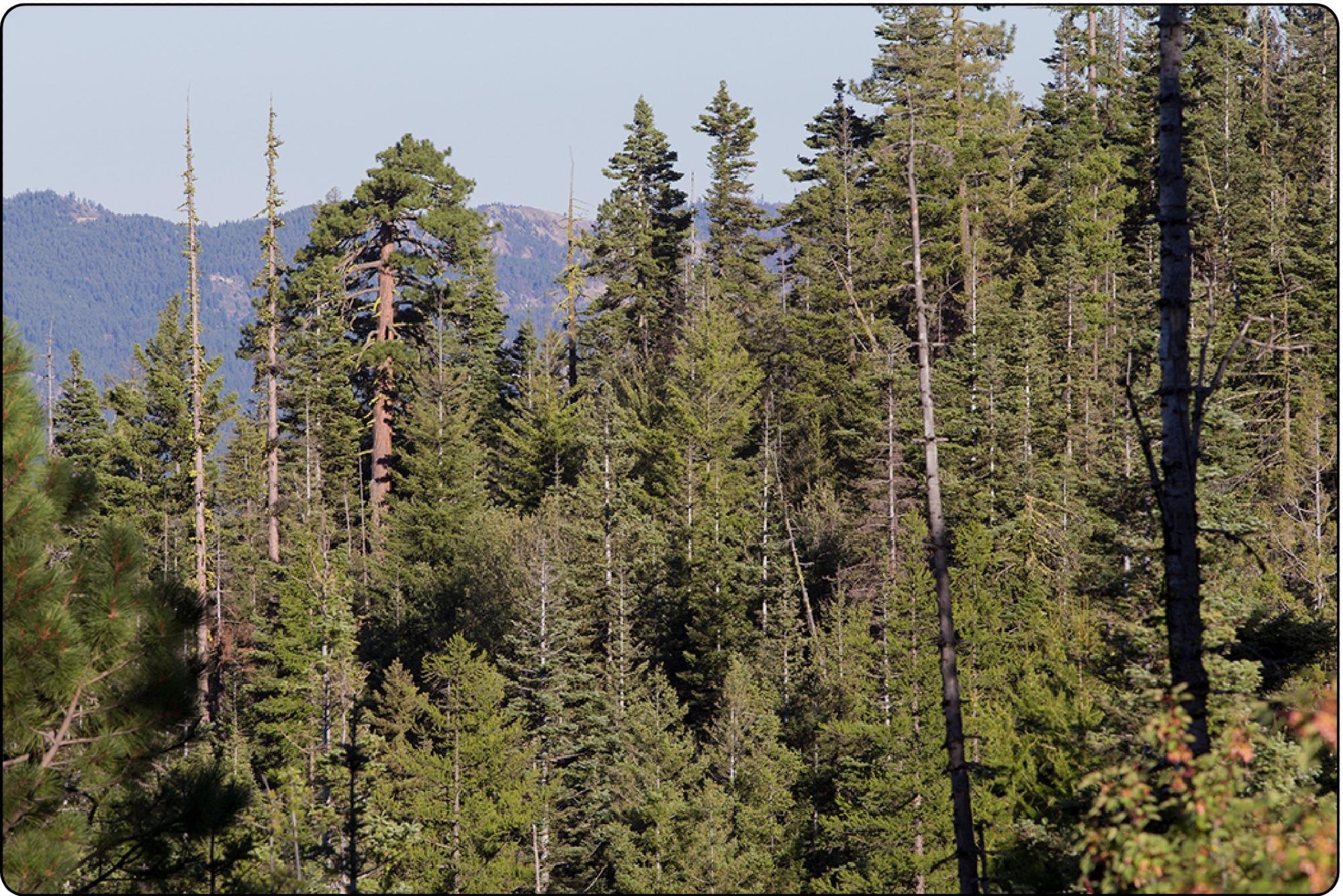
Figure 3. View near Tronsen Ridge (in the background), 2013, Okanogan-Wenatchee National Forest, Washington. Only a handful of trees in this scene were present 125 to 150 years ago. The largest ponderosa pines are 300 to 400 years old, developing under a frequent fire regime. Most other trees are fire-intolerant grand fir and Douglas fir that established over the period of livestock grazing and fire exclusion. A few dwarf mistletoe-infested younger western larch are dead in this scene owing to extreme intertree competition for soil moisture and nutrients, and mistletoe infection severity. Image Credit: Hessburg, et al., 2022
Wildfire and drought continue to threaten these forests and the biota that relies on them, prompting many fire and climate experts to wonder whether major changes to 21st-century landscape composition and structure are required to promote climate—and wildfire—adapted conditions and restore habitat variety.
Discussion
Scientists also have a better understanding of the fact that, while many huge trees perform vital ecological tasks, not all large trees are biologically equal, and that tree size is an inconsistent measure of tree age, as some aged trees are small and other young trees have great diameters. Adaptability to wildfires and climate warming is also influenced by the tree species kept.
The remaining trees provide shade and have been fire-resistant for more than 170 years; examples include grand fir (Abies grandis), immature Douglas fir (Pseudotsuga menziesii), and white fir (Abies concolor). These three species are fire-resistant until they grow and have a thick bark. They were once small companions of the most often burnt inland Pacific Northwest woods.
Low-density fire-tolerant species are also better suited to shifting climate and wildfire regimes, planned burning and managed wildfires, and have lower insect susceptibility.
As the modern climate continues to modify biophysical ecosystems and wildfire regimes, landscape-level planning is required to identify how fire-tolerant and intolerant species, and also open and closed canopy forest successional conditions, should be conserved.
Research has also shown that regulations that apply the same rules to everyone are incompatible with managing resilient landscapes and their supporting systems. Researchers identify different environmental gradients throughout montane PNW landscapes that may sustain a wide range of forest structural and compositional patterns, as well as their associated biodiversity.
Management recommendations that allow for the creation of structural and compositional complexity that enables biodiversity retain wildfire regimes, and other forest attributes will be more likely to succeed. It is still necessary to strike a balance between many goals, such as preserving habitat for animal species that rely on shade-tolerant trees.
Results
Changes in forest health and fire regimes, according to studies, amplify the consequences of global warming and continued active fire suppression. This more diverse patchwork would limit fire spread rates, fireline intensity, flame length, and crown fire potential, as well as foster more beta habitat variety (Figure 4).
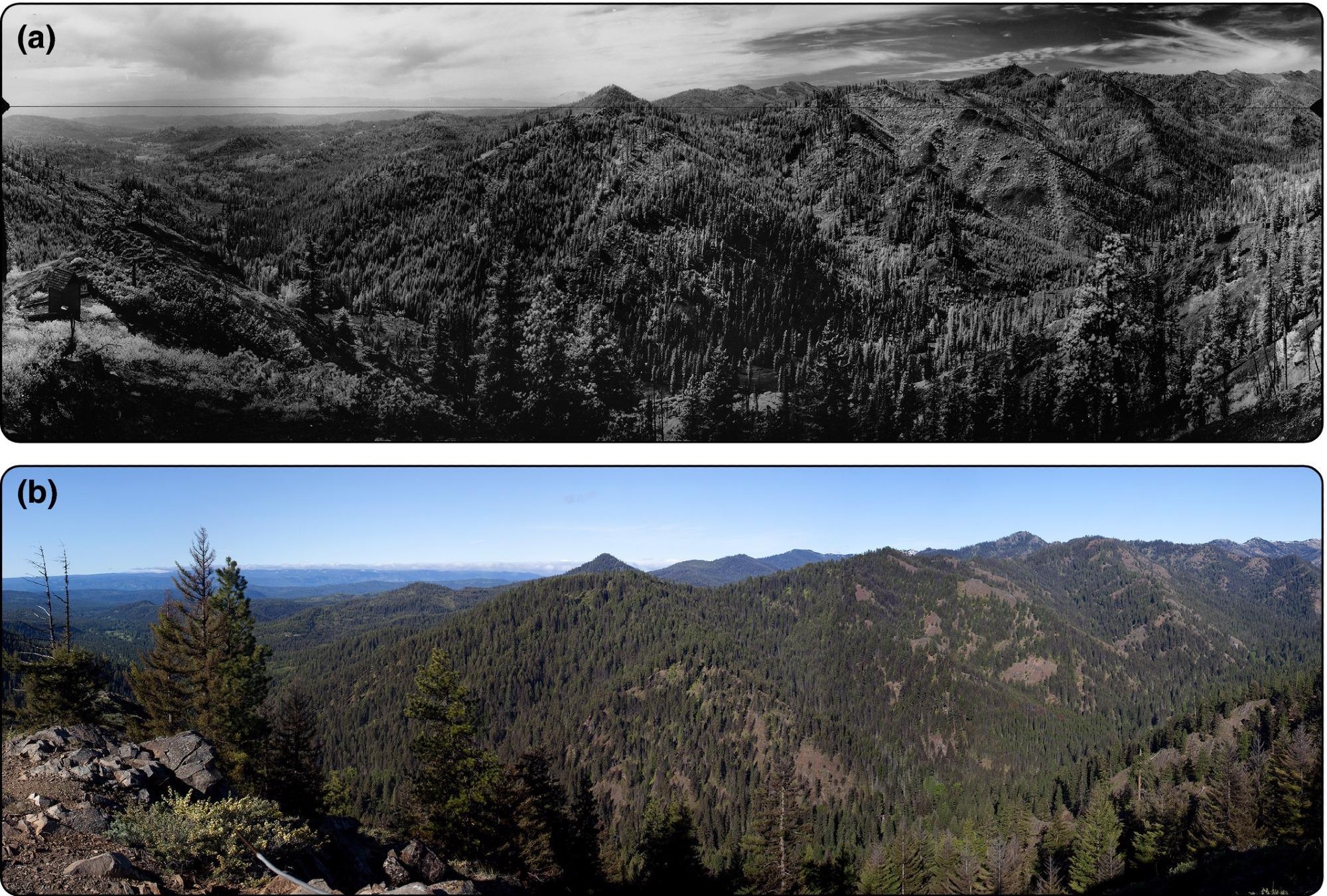
Figure 4. Young shade-tolerant and fire-intolerant trees rapidly fill in the forest. Over 150 years, a dry and moist mixed-conifer forest landscape has become densely filled with Douglas fir and grand fir pole-, small-, medium-, and large-sized trees. View looking southwest into Stafford Creek, North Fork Teanaway River watershed, Cle Elum, Washington, in (a) 1934 and (b) 2013. (a) RL Cooper; National Archives and Records Administration, Seattle. Image Credit: Hessburg, et al., 2022
Federal managers have the potential to significantly boost native biodiversity and forest resilience to wildfires and future climate change by:
- Adopting whole landscape thinking and spatially varied topo-edaphic templates
- By fire through controlled burning or managed wildfire
- Reintroducing fire-tolerant early seral species
- Retaining and developing existing old trees and forests
- Using age rather than diameter
- Creating treatment patches that match the topographic template
- Favoring the removal of fire-intolerant species
- Smoothing tiny ponderosa pine and western larch in areas with ample stocking
- Constructing and financing clear effective implementation and tracking protocols
Harvesting small to big white fir while conserving huge and ancient pines has been agreed upon by several collaborative organizations. Furthermore, if collected trees are processed locally, there is more support for removal procedures, resulting in economic advantages for local communities.
It will be a social as well as an ecological concern whether to encourage climate and wildfire adaption in inland PNW forests. Those who simply oppose tree removal or wish to save shade-tolerant species may find the recommended climate and wildfire adaption strategies difficult to accept.
Conclusion
Federal land management agencies are now struggling to build the social capital required to adapt forests and boost resilience to wildfires, climate change, and other environmental changes. Agreements will be easier to reach if policies and planning standards explicitly define adaptation targets. To generate a common vision for management, effective public involvement, collaboration, and tribal consultation are essential.
Demonstration projects that create “zones of agreement” and acquiescence to adaptation and targets monitoring can help to speed things up. Success is rare if agencies rush to adjust policies without building trust and consensus.
Journal Reference
Hessburg, P.F., Charnley, S., Gray, A.N., Spies, T.A., Peterson, D.W., Flitcroft, R.L., Wendel, K.L., Halofsky, J.E., White, E.M., and Marshall, J. (2022). Climate and wildfire adaptation of inland Northwest US forests. Frontiers in Ecology and the Environment, 20(1), pp.40-48. Available Online: https://esajournals.onlinelibrary.wiley.com/doi/full/10.1002/fee.2408.
References and Further Reading
- Agee, J K & Skinner C N (2005) Basic principles of forest fuel reduction treatments. Forest Ecology and Management,211, pp. 83–96. doi.org/10.1016/j.foreco.2005.01.034.
- Barros, A. M., et al. (2018) Wildfires managed for restoration enhance ecological resilience. Ecosphere, 9, p. e02161. doi.org/10.1002/ecs2.2161.
- Boisramé, G. F., et al. (2017) Vegetation change during 40 years of repeated managed wildfires in the Sierra Nevada, California. Forest Ecology and Management, 402, pp. 241– 52. doi.org/10.1016/j.foreco.2017.07.034.
- Bradford, J B & Bell, D M (2017) A window of opportunity for climate-change adaptation: easing tree mortality by reducing forest basal area. Frontiers in Ecology and the Environment, 15, pp. 11–17. doi.org/10.1002/fee.1445.
- Brown, P. M., et al. (2019) Identifying old trees to inform ecological restoration in montane forests of the central Rocky Mountains, USA. Tree-Ring Research, 75, pp. 34– 48. doi.org/10.3959/1536-1098-75.1.34.
- Buchanan, J., et al. (2003) Nest-site habitat use by white-headed woodpeckers in the eastern Cascade Mountains, Washington. Northwestern Naturalist, 84, pp. 119–28. doi.org/10.2307/3536537.
- Burns, M & Cheng, AS (2007) Framing the need for active management for wildfire mitigation and forest restoration. Society & Natural Resources, 20, pp. 245–59. doi.org/10.1080/08941920601117348.
- Burns, R M & Honkala, B H (1990) Silvics of North America (vol 1). Conifers. Washington, DC: US Forest Service.
- Calkin, D. E., et al. (2015) Negative consequences of positive feedbacks in US wildfire management. Forest Ecosystems, 2, p. 9.
- Churchill, D. J., et al. (2013) Restoring forest resilience: from reference spatial patterns to silvicultural prescriptions and monitoring. Forest Ecology and Management, 291, pp. 442–57. doi.org/10.1016/j.foreco.2012.11.007.
- Coop, J. D., et al. (2020) Wildfire-driven forest conversion in western North American landscapes. BioScience, 20, pp. 1–15. doi.org/10.1093/biosci/biaa061.
- Dale, V. H., et al. (2001) Climate change and forest disturbances: climate change can affect forests by altering the frequency, intensity, duration, and timing of fire, drought, introduced species, insect and pathogen outbreaks, hurricanes, windstorms, ice storms, or landslides. BioScience, 51, pp. 723–34. doi.org/10.1641/0006-3568(2001)051[0723:CCAFD]2.0.CO;2.
- Davis, E. J., et al. (2017) Comparison of USDA Forest Service and stakeholder motivations and experiences in collaborative federal forest governance in the western United States. Environmental Management, 60, pp. 908–21. doi.org/10.1007/s00267-017-0913-5.
- Davis, E. J., et al. (2018) Forest collaborative groups engaged in forest health issues in eastern Oregon. In: J Urquhart, M Marzano, and C Potter (Eds). The human dimensions of forest and tree health: global perspectives. London, UK: Palgrave MacMillan. doi.org/10.1007/978-3-319-76956-1_15.
- Davis, K. T., et al. (2019) Wildfires and climate change push low-elevation forests across a critical climate threshold for tree regeneration. Proceedings of the National Academy of Sciences of the United States of America USA,116, pp. 6193–98. doi.org/10.1073/pnas.1815107116.
- Domke, G. M., et al. (2020) Tree planting has the potential to increase carbon sequestration capacity of forests in the United States. Proceedings of the National Academy of Sciences of the United States of America USA, 117, pp. 24649–51. doi.org/10.1073/pnas.2010840117.
- Fettig, C. J., et al. (2007) The effectiveness of vegetation management practices for prevention and control of bark beetle infestations in coniferous forests of the western and southern United States. Forest Ecology and Management, 238, pp. 24–53. doi.org/10.1016/j.foreco.2006.10.011.
- Fischer, A. P., et al. (2016) Wildfire risk as a socioecological pathology. Frontiers in Ecology and the Environment, 14, pp. 276–84. doi.org/10.1002/fee.1283.
- Franklin, J F & Johnson, K N (2012) A restoration framework for federal forests in the Pacific Northwest. Journal of forestry, 110, pp. 429–39. doi.org/10.5849/jof.10-006.
- Franklin, J F & Lindenmayer, D B (2009) Importance of matrix habitats in maintaining biological diversity. Proceedings of the National Academy of Sciences of the United States of America USA, 106, pp. 349–50. doi.org/10.1073/pnas.0812016105.
- Franklin, J. F., et al. (2018) Ecological forest management. Long Grove, IL: Waveland Press.
- Gaines, W. L., et al. (2007) Short-term response of land birds to ponderosa pine restoration. Restoration Ecology, 15, pp. 670–78. doi.org/10.1111/j.1526-100X.2007.00279.x.
- Graham, R. T,et al. (2004) Science basis for changing forest structure to modify wildfire behavior and severity. Fort Collins, CO: US Forest Service, Rocky Mountain Research Station.
- Hagmann, R. K., et al. (2021) Evidence for widespread changes in the structure, composition, and fire regimes of western North American forests. Ecological Applications. doi.org/10.1002/eap.2431.
- Hagmann, R. K., et al. (2017) Historical and current forest conditions in the range of the northern spotted owl in south central Oregon, USA. Forest Ecology and Management, 389, pp. 374–85. doi.org/10.1016/j.foreco.2016.12.029.
- Hessburg, PF & Agee J K (2003) An environmental narrative of inland Northwest United States forests, 1800–2000. Forest Ecology and Management, 178, pp. 23–59. doi.org/10.1016/S0378-1127(03)00052-5.
- Hessburg, P. F.,et al. (2005) Dry forests and wildland fires of the inland Northwest USA: contrasting the landscape ecology of the pre-settlement and modern eras. Forest Ecology and Management, 211, pp. 117–39. doi.org/10.1016/j.foreco.2005.02.016.
- Hessburg, P. F., et al. (2020) The 1994 Eastside Screens large-tree harvest limit: review of science relevant to forest planning 25 years later. Portland, OR: US Forest Service, Pacific Northwest Research Station.
- Hessburg, P. F., et al. (2015) Restoring fire-prone inland Pacific landscapes: seven core principles. Landscape Ecology, 30, pp. 1805–35. doi.org/10.1007/s10980-015-0218-0.
- Hessburg, P. F., et al. (2019) Climate, environment, and disturbance history govern resilience of western North American forests. Frontiers in Ecology and Evolution, 7, p. 239. doi.org/10.3389/fevo.2019.00239.
- Hessburg, P. F., et al. (2016) Tamm Review: management of mixed-severity fire regime forests in Oregon, Washington, and Northern California. Forest Ecology and Management, 366, pp. 221–50. doi.org/10.1016/j.foreco.2016.01.034.
- Higuera, P. E., et al. (2019) Integrating subjective and objective dimensions of resilience in fire-prone landscapes. BioScience, 69, pp. 379–88. doi.org/10.1093/biosci/biz030.
- Hurteau, M. D., et al. (2008) Carbon protection and fire risk reduction: toward a full accounting of forest carbon offsets. Frontiers in Ecology and the Environment, 6, pp. 493–98. doi.org/10.1890/070187.
- Johnson, K. N., et al. (2008) A plan for the Klamath Tribes’ management of the Klamath Reservation Forest. Chiloquin, OR: Klamath Tribes.
- Keane, R. E., et al. (2009) The use of historical range and variability (HRV) in landscape management. Forest Ecology and Management, 258, pp. 1025–37. doi.org/10.1016/j.foreco.2009.05.035.
- Kimmerer, RW & Lake, F K (2001) The role of indigenous burning in land management. Journal of Forestry, 99, pp. 36–41.
- Krofcheck, D. J., et al. (2018) Prioritizing forest fuels treatments based on the probability of high-severity fire restores adaptive capacity in Sierran forests. Global Change Biology, 24, pp. 729–37. doi.org/10.1111/gcb.13913.
- Lake, F K (2007) Traditional ecological knowledge to develop and maintain fire regimes in northwestern California, Klamath-Siskiyou bioregion: management and restoration of culturally significant habitats (PhD dissertation). Corvallis, OR: Oregon State University.
- Langston N (1995) Forest dreams, forest nightmares: the paradox of old growth in the inland West. Seattle, WA: University of Washington Press.
- Larson, A J & Churchill, D J (2012) Tree spatial patterns in fire-frequent forests of western North America, including mechanisms of pattern formation and implications for designing fuel reduction and restoration treatments. Forest Ecology and Management, 267, pp. 74–92. doi.org/10.1016/j.foreco.2011.11.038.
- LeFevre, M. E, et al. (2020) Evaluating restoration treatment effectiveness through a comparison of residual composition, structure, and spatial pattern with historical reference sites. Forest Science, 66, pp. 578–88. doi.org/10.1093/forsci/fxaa014.
- Liang, S., et al. (2018) Large-scale restoration increases carbon stability under projected climate and wildfire regimes. Frontiers in Ecology and the Environment, 16, pp. 207–12. doi.org/10.1002/fee.1791.
- Lillybridge, T. R., et al. (1995) Field guide for forested plant associations of the Wenatchee National Forest. Portland, OR: US Forest Service, Pacific Northwest Research Station. doi.org/10.2737/PNW-GTR-359.
- Long, J. W., et al. (2018) Tribal ecocultural resources and engagement. Portland, OR: US Forest Service, Pacific Northwest Research Station.
- Matlack, G R &Litvaitis J (1999) Forest edges. In: ML Hunter (Ed). Maintaining biodiversity in forest ecosystems. New York, NY: Cambridge University Press. doi.org/10.1017/CBO9780511613029.008.
- McCaffrey, S., et al. (2013) Social science research related to wildfire management: an overview of recent findings and future research needs. International Journal of Wildland Fire, 22, pp. 15–24.
- Meigs, G. W., et al. (2020) Influence of topography and fuels on fire refugia probability under varying fire weather conditions in forests of the Pacific Northwest, USA. Canadian Journal of Forest Research, 50, pp. 636–47. doi.org/10.1139/cjfr-2019-0406.
- North, M. P.,et al. (2012) Using fire to increase the scale, benefits, and future maintenance of fuels treatments. Journal Forest, 110, pp. 392–401. doi.org/10.5849/jof.12-021.
- North, M. P., et al. (2015) Reform forest fire management. Science, 349, pp. 1280–81. doi.org/10.1126/science.aab2356.
- Otis, D S (2014)The Dawes Act and the allotment of Indian lands. Norman, OK: University of Oklahoma Press.
- Parks, S A & Abatzoglou, J T (2020) Warmer and drier fire seasons contribute to increases in area burned at high severity in western US forests from 1985–2017. Geophysical Research Letters, 47, p. e2020GL089858. doi.org/10.1029/2020GL089858.
- Penman, T. D., et al. (2011) Prescribed burning: how can it work to conserve the things we value? International Journal of Wildland Fire, 20, pp. 721–33.
- Perry, D. A., et al. (2011) The ecology of mixed severity fire regimes in Washington, Oregon, and northern California. Forest Ecology and Management, 262, pp. 703–17. doi.org/10.1016/j.foreco.2011.05.004.
- Pollet, J & Omi, P N (2002) Effect of thinning and prescribed burning on crown fire severity in ponderosa pine forests. International Journal of Wildland Fire, 11, pp. 1–10. doi.org/10.1071/WF01045.
- Powell, D C (2013) Eastside Screens chronology. Pendleton, OR: US Forest Service, Pacific Northwest Region.
- Prichard, S. J., et al. (2021) Adapting western North American forests to climate change and wildfires: ten common questions. Ecological Applications. doi.org/10.1002/eap.2433.
- Prichard, S. J., et al. (2017) Tamm Review: shifting global fire regimes: lessons from reburns and research needs. Forest Ecology and Management, 396, pp. 217–33. doi.org/10.1016/j.foreco.2017.03.035.
- Pyne, S J (1997) World fire: the culture of fire on Earth. Seattle, WA: University of Washington Press.
- Pyne, S J (2001) Year of the fires: the story of the great fires of 1910. New York, NY: Viking Press.
- Raphael, M. G., et al. (2001) Status and trends of habitats of terrestrial vertebrates in relation to land management in the interior Columbia River Basin. Forest Ecology and Management, 153, pp. 63–87. doi.org/10.1016/S0378-1127(01)00454-6.
- Russell, R. E., et al. (2007) Habitat-suitability models for cavity-nesting birds in a postfire landscape. Journal of Wildlife Management, 71, pp. 2600–11. doi.org/10.2193/2007-034.
- Singleton, P. H., et al. (2010) Barred owl space use and habitat selection in the eastern Cascades, Washington. Journal of Wildlife Management, 74, pp. 285–94. doi.org/10.2193/2008-548.
- Spies, T. A., et al. (2018) Old growth, disturbance, forest succession, and management in the area of the Northwest Forest Plan. Portland, OR: US Forest Service, Pacific Northwest Research Station.
- Spies, T. A., et al. (2019) Twenty-five years of the Northwest Forest Plan: what have we learned? Frontiers in Ecology and the Environment, 17, pp. 511–20. doi.org/10.1002/fee.2101.
- Spies, T. A., et al. (2018) Adaptation in fire-prone landscapes: interactions of policies, management, wildfire, and social networks in Oregon, USA. Ecology and Society, 23, p. 11. doi.org/10.5751/ES-10079-230211.
- Spies, T. A., et al. (2014) Examining fire-prone forest landscapes as coupled human and natural systems. Ecology and Society, 19, p. 3. doi.org/10.5751/ES-06584-190309.
- Stephens, S. L., et al. (2013) Managing forests and fire in changing climates. Science, 342, pp. 41–42. doi.org/10.1126/science.1240294.
- Stephens, S. L., et al. (2018) Drought, tree mortality, and wildfire in forests adapted to frequent fire. BioScience, 68, pp. 77–88. doi.org/10.1093/biosci/bix146.
- Stephens, S. L., et al. (2015) Historical and current landscape-scale ponderosa pine and mixed-conifer forest structure in the southern Sierra Nevada. Ecosphere, 6, p. 79. doi.org/10.1890/ES14-00379.1.
- Stephens, S. L., et al. (2020) Fire and climate change: conserving seasonally dry forests is still possible. Frontiers in Ecology and the Environment, 18, pp. 354–60. doi.org/10.1002/fee.2218.
- Stevens, J. T., et al. (2020) Biogeography of fire regimes in western US conifer forests: a trait-based approach. Global Ecology and Biogeography, 29, pp. 944–55. doi.org/10.1111/geb.13079.
- Stevens-Rumann, C. S., et al. (2018) Evidence for declining forest resilience to wildfires under climate change. Ecology Letters, 21, pp. 243–52. doi.org/10.1111/ele.12889.
- Stidham, M & Simon-Brown, V (2011) Stakeholder perspectives on converting forest biomass to energy in Oregon, USA. Biomass & Bioenergy, 35, pp. 203–13. doi.org/10.1016/j.biombioe.2010.08.014.
- Sturrock, R. N., et al. (2011) Climate change and forest diseases. Plant Pathology, 60, pp. 133–49. doi.org/10.1111/j.1365-3059.2010.02406.x.
- Taylor, A H & Skinner, C N (2003) Spatial patterns and controls on historical fire regimes and forest structure in the Klamath Mountains. Ecological Applications, 13, pp. 704–19. doi.org/10.1890/1051-0761(2003)013[0704:SPACOH]2.0.CO;2.
- Taylor, A. H., et al. (2016) Socioecological transitions trigger fire regime shifts and modulate fire–climate interactions in the Sierra Nevada, USA, 1600–2015 CE. Proceedings of the National Academy of Sciences of the United States of America, 113, pp. 13684–89. doi.org/10.1073/pnas.1609775113.
- Tepley, A. J., et al. (2017) Vulnerability to forest loss through altered postfire recovery dynamics in a warming climate in the Klamath Mountains. Global Change Biology, 23, pp. 4117–32. doi.org/10.1111/gcb.13704.
- USFS (US Forest Service)(2012) National Forest System Land Management Planning, 36 CFR Part 219, RIN 0596-AD02. Federal Register, 77, pp. 21162–276.
- van Pelt, R (2008) Identifying old trees and forests in eastern Washington. Olympia, WA: Washington State Department of Natural Resources.
- Westerling, A L (2016) Increasing western US forest wildfire activity: sensitivity to changes in the timing of spring. Philosophical Transactions of the Royal Society B, 371, p. 20150178. doi.org/10.1098/rstb.2015.0178.
- Westerling, A. L., et al. (2006) Warming and earlier spring increase western US forest wildfire activity. Science, 313, pp. 940–43. doi.org/10.1126/science.1128834.
- White, E. M., et al. (2015) Socioeconomic monitoring plan for the US Forest Service’s Eastside restoration efforts. Eugene, OR: University of Oregon.
- Wiens, J. A., et al. (2012) Historical environmental variation in conservation and natural resource management. Hoboken, NJ: John Wiley & Sons. doi.org/10.1002/9781118329726.